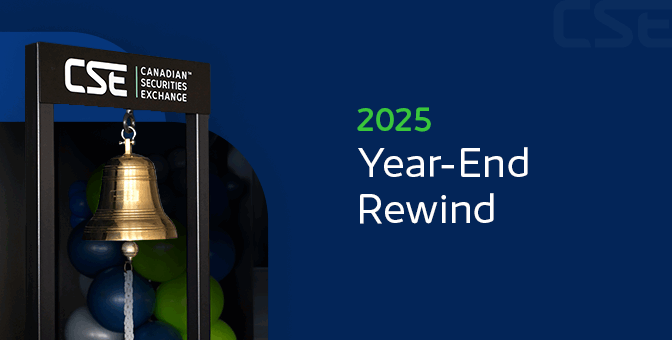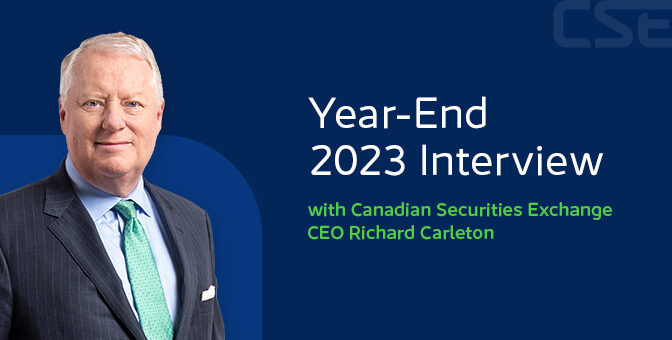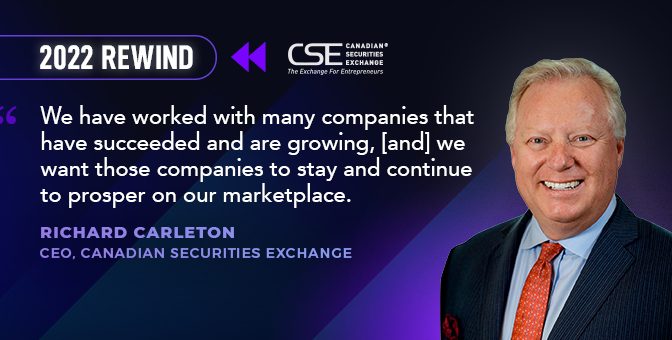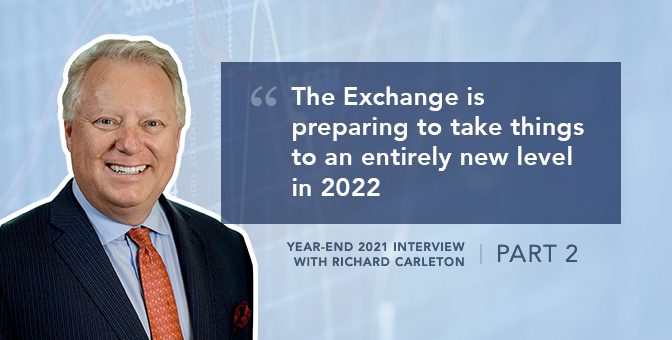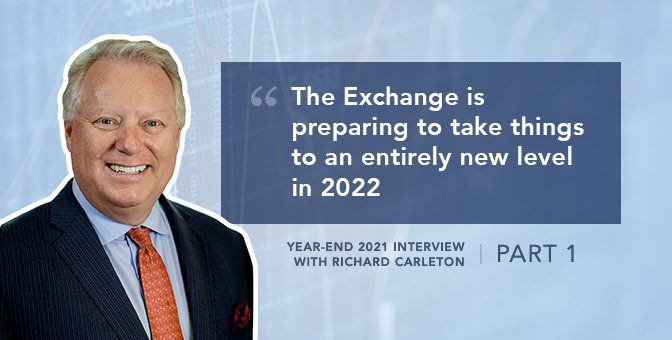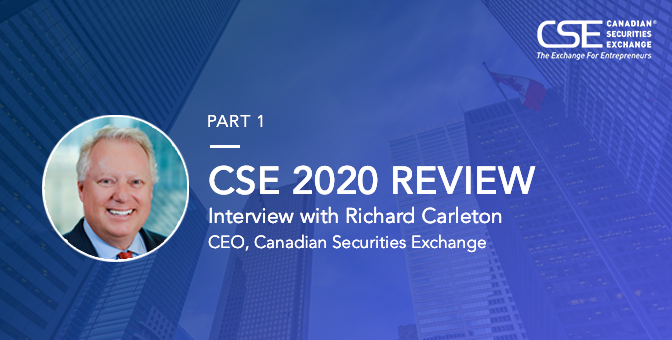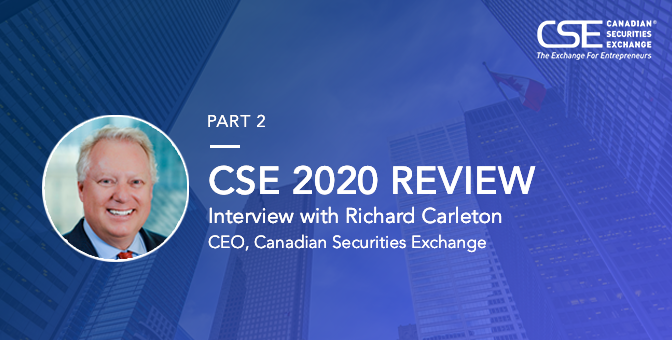January Highlights
As 2025 comes to an end, we’re sharing our favourite highlights from another incredible year at the CSE. In January, we hit the ground running with a strong presence at VRIC, hosted our signature Mining Over Canada Reception, joined global financial market leaders on the slopes of the Italian Alps, and released our first podcast episode of the year.
VRIC 2025
The Vancouver Resource Investment Conference (VRIC), presented by Jay Martin, President and CEO of Cambridge House International, returned on January 19-20 for another memorable year.
The CSE was pleased to exhibit at and connect with friends old and new at this renowned mining event, which featured over 100 expert speakers, a dynamic tradeshow and exhibition, and valuable networking opportunities.
Beyond the trade floor, we took part in the panel, “List Local, Trade Global: The Pubco Opportunity in Challenging Markets,” which was moderated by the CSE’s Anna Serin and featured the CSE’s James Black and Jason Paltrowitz from OTC Markets Group.
Plus, we had the opportunity to distribute copies of the special VRIC edition of Canadian Securities Exchange Magazine.
And it was great to catch up with CSE listed issuers also in attendance:
- Core Nickel (CSE:CNCO)
- Emperor Metals (CSE:AUOZ)
- Getchell Gold (CSE:GTCH)
- Golden Cariboo Resources (CSE:GCC)
- Headwater Gold (CSE:HWG)
- Inflection Resources (CSE:AUCU)
- Prismo Metals (CSE:PRIZ)
- Prospect Ridge Resources (CSE:PRR)
- Provenance Gold (CSE:PAU)
- Red Canyon Resources (CSE:REDC)
- Western Uranium & Vanadium (CSE:WUC)
- Westward Gold (CSE:WG)
- Yukon Metals (CSE:YMC)
View the Album: VRIC 2025 Highlights
The CSE’s Mining Over Canada Reception
Back and better than ever, the CSE’s annual Mining Over Canada Reception was once again a standout highlight of VRIC.
Held at the historic Vancouver Club, the signature CSE event brought together issuers and members of the capital markets and mining communities for a night of lively conversations, outstanding food and drinks, and great company.
We are appreciative to everyone who joined us, as well as our event sponsors, Morton Law LLP, MNP, Haywood Securities, Kitco Mining, Odyssey Trust Company, Business Television (BTV), and Venture Liquidity Providers.
View the Album: Mining Over Canada Reception Highlights
Interbourse 2025
CSE CEO Richard Carleton hit the slopes in the Italian Alps for the 56th edition of Interbourse, an event we were proud to sponsor.
It was a fantastic week of connection, camaraderie, and competition in beautiful Courmayeur, Italy, as Richard gathered with representatives from exchanges, clearing firms, institutional brokerages, trading firms, and financial technology firms from around the world.
A big kudos to Team London for hosting this year’s festivities!
The Exchange for Entrepreneurs Podcast: 2024 Recap
We kicked off 2025 with a special episode of The Exchange for Entrepreneurs Podcast with the CSE’s Anna Serin and Bruce Campbell from StoneCastle Investment Management.
In this episode, they discussed what happened in the capital markets in 2024, including gold performance, interest rates, technology, cannabis, and financing trends, and previewed what to look out for in 2025, such as sector rotation and the impact of U.S. and Canadian politics.
Watch Now: Anna Serin and Bruce Campbell Recap the 2024 Markets | The CSE Podcast E6-S4
Market Open: Women in Mining BC
The CSE was pleased to welcome the Women in Mining BC (WIMBC) board of directors to open the market from our Vancouver office and to speak to director Sarah Martin about the work being done by WIMBC to foster connection and inspiration within the diverse mining workforce in British Columbia.
Watch Now: Women in Mining BC Opens the Market | January 28, 2025
February Highlights
In February, we travelled to Atlantic City for The Microcap Conference, published the 2025 edition of The Mining Issue of our magazine, released new episodes on our existing and brand-new podcast, spoke at the Urbana Private Equity Investor Day Conference, and swapped toques for sunglasses during a productive visit to Miami, Florida.
The Microcap Conference
The Microcap Conference, organized by DealFlow Events, returned for another highly anticipated edition in Atlantic City.
Now the largest independent microcap conference in the U.S., this event welcomed microcap companies, investors, and deal-makers from across a wide range of sectors. We enjoyed exploring topics critical to the microcap community and catching up with CSE listed issuers, FendX Technologies (CSE:FNDX) and Railtown AI Technologies (CSE:RAIL), all against the exciting backdrop of America’s Playground.
View Highlights: The Microcap Conference 2025
Canadian Securities Exchange Magazine: The Mining Issue
In this year’s Mining Issue of Canadian Securities Exchange Magazine, we feature six Canadian companies that are leaning into innovation and expertise to meet global demand for strategic minerals, precious metals, and greater energy supply.
Plus, we spotlight exclusive insights from top mining experts and CSE Director of Listings Development Phillip Shum, who shares his journey to the Exchange, views on capital markets, and tips for companies going public.
The companies featured in this issue are:
- Forge Resources (CSE:FRG)
- Ares Strategic Mining (CSE:ARS)
- Forte Minerals (CSE:CUAU)
- PTX Metals (CSE:PTX)
- Kuya Silver (CSE:KUYA)
- Quebec Innovative Materials (CSE:QIMC)
Read the Issue: Canadian Securities Exchange Magazine: The Mining Issue March 2025
The Exchange for Entrepreneurs Podcast: S4-E7–E10 “Mining Market Outlook”
At this year’s Vancouver Resource Investment Conference (VRIC), the CSE sat down with four prolific mining and investment industry leaders to get their perspectives on trends and forces shaping the markets.
On this “Mining Market Outlook” series on The Exchange for Entrepreneurs Podcast, we dive into gold, ESG, and more with Miles Franklin President and CEO Andy Schectman; Rule Investment Media CEO Rick Rule; Pan American Silver and Equinox Gold Chairman Ross Beaty; and Exploration Insights Founder and Senior Advisor Brent Cook.
View the Playlist: The Exchange for Entrepreneurs Podcast
The Market This Month: S1-E1
The CSE, in partnership with Stockhouse, was proud to launch the inaugural episode of The Market This Month. In this debut episode, the CSE’s Anna Serin teams up with financial expert Bruce Campbell from StoneCastle Investment Management to explore the latest trends in junior and small-cap markets – from the evolving impact of tariffs and trade dynamics to emerging opportunities in the resource and energy sectors.
Watch Now: Tariffs and Trade Tensions on The Market This Month | S1-E1
Urbana Private Equity Investor Day Conference
At Urbana Corporation’s (CSE:URB) fourth annual Urbana Private Equity Investor Day Conference, CSE CEO Richard Carleton spoke about capital formation on the CSE; highlights from 2024 and what’s coming next at the CSE, including global outreach and integration and strategic investments; and his outlook on crypto, gold, and more.
Watch Now: Richard Carleton, CEO, CSE | Urbana Private Equity Investor Day 2025
Going Public and Raising Capital in Canada (Miami)
The CSE team was pleased to connect with entrepreneurs and capital markets leaders in Miami Beach, Florida, for another fantastic Going Public and Raising Capital in Canada session.
Co-hosted by Corporate Counsel, this year’s Going Public and Raising Capital in Canada featured a stellar lineup of expert speakers who provided their perspectives on current market conditions and the opportunities to access public capital in Canada. CSE CEO Richard Carleton also delivered a timely presentation entitled “Why Canada?”
Special thanks to Michael Bluestein from Corporate Counsel as well as to Maruf Raza from MNP, Danielle Fernandes from Bantr, Jeff Swinoga from Exploits Discovery (CSE:NFLD), Michael Astone from ArcStone Securities and Investments, Joe Fars from Red Cloud Securities, and Miranda Werstiuk from Monetary Metals.
View the Album: Going Public and Raising Capital in Canada (Miami 2025)
Mines and Money Miami
Following our Going Public event, the CSE team attended Mines and Money Miami in the city’s vibrant downtown. Here, connecting with attendees in the mining financing ecosystem and catching up with exhibiting CSE listed issuers, American Pacific Mining (CSE:USGD), American Tungsten (CSE:TUNG), and Exploits Discovery (CSE:NFLD).
March Highlights
In March, we joined our colleagues in preparing for a legendary mining convention, embarked on our annual PDAC event circuit, hosted networking sessions with peers from Canada and around the globe, and rang the bell for gender equality.
Red Cloud Pre-PDAC Mining Showcase
To help us gear up for PDAC, Red Cloud Financial Services, in partnership with PearTree, hosted the annual Pre-PDAC Mining Showcase.
Our team enjoyed having insightful conversations with mining industry peers as well as catching engaging presentations from CSE listed issuers in attendance, including Foremost Clean Energy (CSE:FAT), Kobrea Exploration (CSE:KBX), Mustang Energy (CSE:MEC), and Nova Pacific Metals (CSE:NVPC).
View Highlights: Red Cloud Pre-PDAC Mining Showcase 2025
PDAC 2025
As always, the PDAC Convention, organized by the Prospectors and Developers Association of Canada, was incredible!
The CSE team had a fantastic time connecting with the mining and exploration community, investors, business leaders, and government representatives from around the world.
Plus, the Exchange was well-represented at this year’s show, with nearly 30+ CSE listed companies exhibiting and participating in the myriad networking events throughout this conference, including:
- bitibi Metals (CSE:AMQ)
- American Salars Lithium (CSE:USLI)
- Appia Rare Earths & Uranium (CSE:API)
- BacTech Environmental (CSE:BAC)
- Cascade Copper (CSE:CASC)
- Dundee Sustainable Technologies (CSE:DST)
- Emperor Metals (CSE:AUOZ)
- Exploits Discovery (CSE:NFLD)
- Fathom Nickel (CSE:FNI)
- Foremost Clean Energy (CSE:FAT)
- Forte Minerals (CSE:CUAU)
- Giant Mining (CSE:BFG)
- Golden Cariboo Resources (CSE:GCC)
- Kuya Silver (CSE:KUYA)
- Military Metals (CSE:MILI)
- Northstar Gold (CSE:NSG)
- NorthX Nickel (CSE:NIX)
- Nuinsco Resources (CSE:NWI)
- Peloton Minerals (CSE:PMC)
- Prismo Metals (CSE:PRIZ)
- Red Metal Resources (CSE:RMES)
- Renforth Resources (CSE:RFR)
- Spod Lithium (CSE:SPOD)
- Talmora Diamond (CSE:TAI)
- Tartisan Nickel (CSE:TN)
- Volta Metals (CSE:VLTA)
- Western Uranium & Vanadium (CSE:WUC)
- Yukon Metals (CSE:YMC)
Thank you to everyone who stopped by our booth, attended one of our many events, or helped make this year’s show one of the best for us and our issuers.
And be sure to revisit The Mining Issue of Canadian Securities Exchange Magazine ahead of PDAC 2026.
View the Album: PDAC 2025
CSE PDAC Investor Luncheon
We were also proud to host another successful PDAC Investor Luncheon. It was a pleasure to bring together members of the mining, investment, and capital markets communities for company presentations, insights, and spectacular networking over a delicious meal.
A big thank you to everyone who attended, the CSE listed issuers and presenting companies that shared their stories, and our sponsors, ACCESS Newswire, DSA Corporate Services, Endeavor Trust, Investor.Events, Independent Trading Group (ITG), Lebeuf Legal, Marrelli Support Services, Market One, Marrelli Trust Company Limited, MNP, OTC Markets Group, Paul Benwell & Associates (PBA), Purves Redmond Limited, Venture Liquidity Providers, and Vested.ca, for supporting this incredible event.
View the Album: CSE’s PDAC Investor Luncheon 2025
Australia Meets Canada Luncheon
This year’s PDAC Australia Meets Canada Luncheon was a big success. It was exciting to gather with friends and colleagues over a delicious meal from Rosie’s Burgers, part of the Happy Belly Food Group (CSE:HBFG).
Our first year as members of The World Federation of Exchanges, we enjoyed sharing insights from recent travels down under and the expanding global trading platforms that are creating new access between our markets.
View Highlights: Australia Meets Canada Luncheon 2025
Mangia Bevi Festa
Our ever-popular exclusive PDAC networking event, Mangia Bevi Festa, returned to the impressive Pilsner Hall at Steam Whistle Brewing in Toronto.
Presented in partnership with MNP, Aird & Berlis LLP, and Alliance Advisors, it was great to connect with friends old and new in the mining and capital markets spaces over great food and drinks.
View Highlights: Mangia Bevi Festa 2025
Ring the Bell for Gender Equality: Market Open With the World Federation of Exchanges
We commemorated International Women’s Day with a special opening bell ceremony in support of the 11th annual Ring the Bell for Gender Equality campaign. This global initiative, backed by the World Federation of Exchanges, promotes the empowerment of women and girls in the financial sector and beyond.
“The CSE fully supports the removal of historic gender pay gaps and ensuring that ‘glass ceilings’ preventing the advancement of women are permanently shattered,” noted CSE CFO Mary Anne Palangio at the ceremony.
We’re proud to share that 49% of CSE staff are women, with 43% holding senior leadership positions.
Watch Now: CSE Rings the Bell for Gender Equality | Monday, March 10, 2025
April Highlights
In April, we reached a major milestone, released a new episode of our podcast, held a special market open, travelled to the ever-exciting Las Vegas, met Capital Markets Mongolia in New York, and debuted our Summit on Responsible Investment content series.
CSE Listings Now Eligible for Trading on Interactive Brokers
In April, we were proud to announce that all CSE listed securities are now eligible for trading on the Interactive Brokers (IBKR) global platform, which will increase liquidity, enhance price discovery, and support capital formation activities by CSE issuer companies.
“This milestone underlines the growth and success of the CSE and our commitment to support the expanding objectives of our issuers and investors,” said CSE CEO Richard Carleton.
IBKR is an award-winning, low-cost, automated electronic broker with approximately 3.6 million client accounts and nearly 3.5 million daily average revenue trades.
“Interactive Brokers offers access to over 160 markets worldwide, competitive pricing, and advanced trading technology,” said Interactive Brokers EVP of Marketing and Product Development Steve Sanders. “The addition of CSE listed securities expands our broad range of investment products, empowering clients to further diversify their portfolios, and underscores our continued commitment to supporting investor access to Canadian markets.”
Thank you to the team at Interactive Brokers Canada for adding CSE securities to your platform!
Chris King on The CSE Podcast
On this episode of The CSE Podcast, the CSE’s James Black sat down with OTC Markets Group Senior VP Chris King to break down the launch of the OTCID tier, including SEC Rule 15c2-11 and the discontinuation of the Pink Current tier, the features of this new platform, and next steps for Canadian-listed companies to maintain access to U.S. investors and trading platforms.
Watch Now: Chris King on the OTCID Evolution for Pink Securities | The CSE Podcast E12-S4
Market Open: Canadian Cancer Society
To mark the close of Daffodil Month, a national campaign that raises awareness and support for cancer research, prevention, and care, the CSE had the pleasure of hosting the Canadian Cancer Society (CCS) as they opened the market at our Toronto office, which included speeches from cancer survivors, Charles Petersen and Steven Hodges, and CCS EVP Sara Oates.
Watch Now: Canadian Cancer Society Opens the Market | Daffodil Month 2025
Planet MicroCap Showcase: VEGAS 2025
It was great to return to the entertainment capital of the world as a sponsor at Planet MicroCap Showcase: VEGAS 2025, produced in partnership with MicroCapClub, which took place at the famed Paris Las Vegas Hotel & Casino.
As always, we enjoyed learning about emerging trends, connecting with leaders in the microcap investment community, and catching up with American Aires (CSE:WIFI), who gave a stellar presentation.
View Highlights: Planet MicroCap Showcase: VEGAS 2025
Mongolia Investment Forum: New York 2025
We were pleased to have the unique opportunity to explore Mongolia’s opportunities in banking, renewables, and critical minerals at the Mongolia Investment Forum: New York 2025.
Hosted by Capital Markets Mongolia, the event took place in the Well& by Durst at One Five One event space in New York City and convened global investors, policymakers, and business leaders.
View Highlights: Mongolia Investment Forum: New York 2025
Summit on Responsible Investment 2025 Series Debut: Earth Day Interview With RootMaker
The CSE hosted the third annual Summit on Responsible Investment (SoRI) in June 2025. Leading up to the Summit, we recorded a series of exclusive interviews and pre-event content, including a special interview in celebration of Earth Day.
RootMaker Products Company CEO Jim Duggan joined the CSE’s Anna Serin for a conversation on how healthy roots lead to healthier trees, how RootMaker products reduce seedling mortality from over 85% to just 5%, and their vision for replacing single-use plastic in planting systems.
View Highlights: Revolutionizing How Trees are Grown – An Earth Day Special | SoRI 2025
May Highlights
As the new year approaches, we’re reflecting on the defining moments that shaped 2025 for the Exchange. In May, we published The Technology Issue of our magazine, attended the inaugural Web Summit Vancouver, took to the stage at the Okanagan Angel Summit, and returned to the Critical Minerals Institute Summit in Toronto.
Canadian Securities Exchange Magazine: The Technology Issue
In this year’s Technology Issue of Canadian Securities Exchange Magazine, we featured six CSE listed technology companies leveraging AI and nanotech to transform everyday systems that improve our health, well-being, and livelihoods.
This edition also includes insights from CSE Event & Content Manager Melissa Robertson, who shared her capital markets journey and insights into the CSE’s thoughtfully curated content mix and events calendar.
Companies featured in this issue include:
- BioMark Diagnostics (CSE:BUX)
- FendX Technologies (CSE:FNDX)
- Metaguest.AI (CSE:METG)
- Railtown AI Technologies (CSE:RAIL)
- Rocket Doctor AI (formerly Treatment.com AI) (CSE:AIDR)
- Sona Nanotech (CSE:SONA)
Read the Issue: Canadian Securities Exchange Magazine: The Technology Issue
Web Summit Vancouver
The first-ever Web Summit event in North America took place in Vancouver, and the CSE was pleased to attend.
This premier technology conference brought together entrepreneurs, investors, media, and industry leaders from around the globe to exchange ideas and explore the trends shaping our future. We had an incredible time connecting with the tech community and learning from some of the industry’s leading experts.
And thank you to everyone who attended our CSE Tech Connect at JOSS for an evening of networking and celebrating this milestone event. Special thanks to Endeavor Trust for helping make our event happen.
View Album: Web Summit Vancouver 2025
Okanagan Angel Summit
We enjoyed sponsoring the Okanagan Angel Summit for its seventh edition and attending the live pitch event on May 22 at the Kelowna Innovation Centre.
As Canada’s entrepreneurial exchange, we’re committed to supporting entrepreneurs, dealers, and funders in growing their businesses. That’s why we were proud to sponsor this pitch competition and investment readiness program, powered by Accelerate Okanagan.
It was inspiring to see the participating entrepreneurs and investors put their eight-week training into action during the pitch competition, where investors heard final pitches from six companies competing for a grand prize investment. Plus, CSE Director of Listings Development for Western Canada Anna Serin took the stage at the quarter-finals.
A big congratulations to Mastrius for being named the winner of the $180,000 grand prize, and to Accelerate Okanagan for organizing such an incredible event.
View Album: Okanagan Angel Summit Finale 2025
CMI Summit IV
The CSE returned to the Critical Minerals Institute (CMI)’s CMI Summit IV at the prestigious National Club in Toronto back in May.
Under the theme “The War for Critical Minerals and Capital Resources,” industry leaders, policymakers, and investors explored the strategic, sustainable, and economic factors vital to critical mineral supply chains.
CSE Vice President of Listings Development James Black delivered a presentation on behalf of the Exchange, and American Tungsten (CSE:TUNG) President Murray Nye and Neotech Metals (CSE:NTMC) Director and CEO Reagan Glazier also took the stage during the event.
View Highlights: CMI Summit IV
June Highlights
This June, we hosted our third annual Summit on Responsible Investment, launched an insightful video series on CSE TV, partnered with CIRO to host an important session, returned to an exclusive mining event, and capped off the month with a trip to Chicago for a leading cannabis conference.
Summit on Responsible Investment 2025: Highlights from Kelowna
On Thursday, June 5, 2025, the Canadian Securities Exchange hosted the third annual Summit on Responsible Investment (SoRI) in beautiful Kelowna, BC.
Under the theme “Creating Value, Stewarding Change,” we had a fantastic time connecting with industry leaders, investors, and innovators for keynotes and thought-provoking discussions on the latest in ESG trends and investment opportunities.
Companies leading in CleanTech, Renewable Energy, and Life Sciences took the spotlight, and a rooftop networking reception provided an exclusive opportunity to connect with professionals shaping the future of responsible investing.
Thank you to our expert guest speakers, Independent Pracademic Dr. Victoria Hurth; Aura Wealth Management Founder Stephen Maser; Cēlandaire Capital Founder and CEO Lida Preyma; BRIDGE© Principal and Founder Siri C. Genik; and Deans Knight CEO Brent Gilchrist for sharing their perspectives, as well as the private companies that joined us to present.
And a big thank you to our sponsors, Endeavor Trust, Vested.ca, Venture Liquidity Providers (VLP), Stockhouse, Crowe MacKay LLP, Lawson Lundell LLP, as well as our community partner, Accelerate Okanagan, for helping make this event possible.
A special shout-out to the CSE listed issuers who gave presentations during the event, including:
- Abound Energy (CSE:ABND)
- BacTech Environmental (CSE:BAC
- Enertopia (CSE:ENRT)
- First Tellurium (CSE:FTEL)
- Hillcrest Energy Technologies (CSE:HEAT)
- Integrated Cyber Solutions (CSE:ICS)
- Pharmala Biotech (CSE:MDMA)
- PreveCeutical Medical (CSE:PREV)
- Replenish Nutrients (CSE:ERTH)
- Rocket Doctor AI (CSE:AIDR) (as Treatment.com AI)
- Sharc International Systems (CSE:SHRC)
We’d also like to thank attendees for their generous contributions to the Central Okanagan Food Bank.
View the Album: Summit on Responsible Investment 2025
CSE Listed Issuer Education Session with CIRO
As part of our ongoing series of issuer education initiatives, we were pleased to host a special online session alongside the Canadian Investment Regulatory Organization (CIRO) this June.
The session provided a unique opportunity for public companies, advisors, and capital markets professionals to hear directly from the teams at CIRO and the CSE about how market supervision works in practice.
From real-time trading surveillance to disclosure standards and enforcement workflows, this session delivered practical insights into how issuers can stay compliant and proactive in today’s regulatory environment.
Topics covered included:
- CIRO’s role in real-time market surveillance and trading halts
- Best practices for mining issuer disclosure (including 43-101 guidance)
- How CIRO investigates market misconduct and collaborates with regulators
- New CSE exchange hold and extended hold period policies
- When and how to interact with CIRO—news pre-filing, surveillance desk, and more
Watch Now: Webinar Replay: CSE Listed Issuer Education Session with CIRO – June 24, 2025
THE Mining Investment EVENT
THE Mining Investment EVENT took place at the Centre des congrès de Québec in Québec City this summer, and the CSE was excited to return as a sponsor of this invitation-only, Tier I global mining investment conference.
We had a fantastic time being in the room with some of the most influential thought leaders in the mining sector and connecting with familiar and new faces.
Plus, several CSE listed issuers were at the event, including:
- Avanti Gold (CSE:AGC)
- Abitibi Metals (CSE:AMQ)
- Blue Lagoon Resources (CSE:BLLG)
- Cupani Metals (CSE:CUPA)
- Emperor Metals (CSE:AUOZ)
- E-Power Resources (CSE:EPR)
- Exploits Discovery (CSE:NFLD)
- First Phosphate (CSE:PHOS)
- Golden Cariboo Resources (CSE:GCC)
- Kuya Silver (CSE:KUYA)
- Peloton Minerals (CSE:PMC)
- Quimbaya Gold (CSE:QIM)
- Temas Resources (CSE:TMAS)
- Terra Balcanica Resources Corp. (CSE: TERA)
- Yukon Metals (CSE:YMC)
View the Album: THE Mining Investment EVENT 2025
IgniteIt’s Cannabis Capital Conference
It was great to be back at IgniteIt‘s Cannabis Capital Conference, one of North America’s leading cannabis events.
As always, the space was buzzing with conversations about the current landscape for cannabis entrepreneurs, both newcomers and industry giants alike. We had a fantastic time connecting with key players and exchanging valuable insights, all while enjoying the world-class city of Chicago.
Plus, CSE listed cannabis issuers also participated in speaking engagements during this three-day event, including Cresco Labs (CSE:CL), iAnthus Capital Holdings (CSE:IAN), LEEF Brands (CSE:LEEF), and MariMed (CSE:MRMD).
View Highlights: IgniteIt’s Cannabis Capital Conference 2025
July Highlights
In July, we swung into summer at our annual CSE Open in Toronto, hosted our ever-popular pancake breakfast at the Calgary Stampede, and held a special Market Open in support of Autism Science Foundation Canada
The CSE Open Toronto
It was great swinging into summer at The CSE Open this July!
Our friends and colleagues joined us at the Royal Ontario Golf Club just outside Toronto for our annual golf event, held in support of the Centennial Infant and Child Centre Foundation and Lions Foundation of Canada Dog Guides.
Thank you to our premier sponsors, MNP, Independent Trading Group, and The Nuvo Group, and all of our other incredible partners and sponsors, including Dog and Pony Studios, LFG Equities, Gowling WLG, RSM Canada, Purves Redmond, Integral Wealth Securities, ALOE Finance, CEO.CA, Corporate Counsel, Computershare, ArcStone Securities and Investments, North Star Investor Relations, Options Technology, Red Cloud Securities, Native, and Corpay.
And congratulations to the winning team of Adam Schmidt, David Archer, Tammy Jurca, and Matt Lee!
View the Album: The CSE Open Toronto 2025
Calgary Stampede 2025
Yahoo! In true CSE tradition, our team dusted off our cowboy hats and headed to the world-famous Calgary Stampede to connect with friends and colleagues at our annual Stampede Breakfast.
As always, we had a fantastic morning enjoying delicious pancakes and great conversations.
Until next year!
View the Album: Calgary Stampede 2025
Market Open: Autism Science Foundation Canada
Ahead of the fourth annual Bay Street Rides FAR, we were pleased to host Autism Science Foundation (ASF) Co-Founder and President Alison Singer and other members of the ASF team for a special market open at CSE HQ in Toronto on July 29.
“Bay Street Rides FAR is a day when fierce competitors become united allies in the fight to understand autism. Whether or not you have a personal connection to autism, everyone is welcome to join or support,” shared Alison Singer, who provided insights into the work the organization is doing and its fundraising event, Rides Far.
Until next year!
Watch now: Bay Street Rides FAR for Autism Research in Toronto
August Highlights
This August, we released the latest Precious Metals Issue of Canadian Securities Exchange Magazine, launched our first-ever Western Market Open, and capped off the month with a client appreciation golf day in Québec.
Canadian Securities Exchange Magazine: The Precious Metals Issue
In the latest Precious Metals Issue of Canadian Securities Exchange Magazine, we featured seven CSE listed companies that are pursuing breakthrough discoveries and deploying innovative strategies to unlock value across North America’s top-tier mining jurisdictions.
The issue also featured an interview with CSE Director of Strategic Planning & Brand Development Renée Colyer, who provided insights into her journey to the Exchange and the CSE’s business strategy and branding.
Companies featured in this issue include:
- Abitibi Metals (CSE:AMQ)
- Blue Lagoon Resources (CSE:BLLG)
- Exploits Discovery (CSE:NFLD)
- Getchell Gold (CSE:GTCH)
- Gold Hunter Resources (CSE:HUNT)
- Headwater Gold (CSE:HWG)
- Yukon Metals (CSE:YMC)
Read the Issue: Canadian Securities Exchange Magazine: The Precious Metals Issue
CSE Western Market Open: VanCap Rising Leaders
This August, we officially launched the CSE Western Market Open, hosted in partnership with Market One.
To celebrate this milestone, we were joined by the VanCap Rising Leaders, a community of young professionals shaping the future of Canada’s capital markets by building connections across legal, audit, brokerage, and market-making roles.
This new initiative gives CSE listed issuers and the broader markets community in Western Canada more opportunities to connect, celebrate milestones, and strengthen networks.
Watch Now: VanCap Rising Leaders Ring the Bell at the First CSE Western Market Open
11th Annual Summer Golf With the CSE
We closed out a successful August with the 11th annual Summer Golf With the CSE at the Mount Bruno Country Club in Saint-Bruno-de-Montarville, Québec.
Our friends and colleagues from across the capital markets joined us for a fun day of golf, followed by cocktails and dinner.
A big thank you to our event partners, MNP, Fasken, and PBA, and to everyone who joined us in making this year’s event a hole in one.
View Highlights: 11th Annual Summer Golf With the CSE
September Highlights
This September, we closed out the 2025 golf season with one more round of friendly competition in Vancouver, travelled to beautiful Colorado for the Precious Metals Summit, rode our bikes for an important cause, hosted another insightful Going Public event, and took part in a panel during the ArcStone-Kingswood Growth Summit.
The CSE Open Vancouver
The Vancouver edition of our client-appreciation golf tournament, The CSE Open 2025, was the perfect send-off for summer.
We went back to the beautiful Gleneagles Golf Course in West Vancouver this September for a day of networking, camaraderie, and friendly competition. Plus, we were proud to once again support Family Services of the North Shore.
A big shout-out to our premier sponsors, DuMoulin Black LLP, as well as our other valued sponsors, MNP, Endeavor Trust, Haywood Securities Inc., Market One, Treewalk, Investor.Events, Venture Liquidity Providers, and Dog and Pony Studios.
Thank you to everyone who joined us, and congratulations to the team of Aydin Asli, Mark Caplan, Richard Carleton, and Salim Dhanji for taking home the win!
View the Album: The CSE Open Vancouver 2025
Precious Metals Summit Beaver Creek
This September, we returned as a sponsor to the Precious Metals Summit at the mountainside Beaver Creek Resort in Colorado.
Set against stunning backdrops, this year’s edition featured insightful corporate presentations, as well as opportunities to connect with the mining investment community and CSE listed issuers in attendance, including:
- Abitibi Metals (CSE:AMQ)
- Blue Lagoon Resources (CSE:BLLG)
- Exploits Discovery (CSE:NFLD)
- Headwater Gold (CSE:HWG)
- Kuya Silver (CSE:KUYA)
- Yukon Metals (CSE:YMC)
A special thanks to Max Cunningham from the National Stock Exchange of Australia (NSX) for joining us at the CSE/NSX Reception and VIP Dinner, and a big thank you to Gowling WLG, Endeavor Trust, and MNP for sponsoring this year’s reception and to everyone who joined us.
View the Album: Precious Metals Summit Beaver Creek 2025
Bay Street Rides FAR
Bay Street Rides FAR was back for another impactful year, and the CSE was proud to once again participate alongside Toronto’s financial community.
It was great to see such a fantastic turnout for this family-friendly day of walking and biking in support of Autism Science Foundation Canada.
A big thank you to everyone who donated through the CSE page and joined us during the event.
View Highlights: Bay Street Rides FAR 2025
Going Public and Raising Capital in Canada
We celebrated another successful Going Public and Raising Capital in Canada event this September. CSE Director of Listings Development Phillip Shum and Senior Advisor of Listings Development Scott Pritchard had a wonderful time catching up with friends old and new in Halifax, Nova Scotia.
During the event, our lineup of expert speakers, George Huang from MNP, Raj Ghosh from Lebeuf Legal, Bill Zawada from Laurel Hill Advisory Group, Seamus Byrne from MI3 Communications Financières, and Zed Wang from Ferrum CPA Professional Corporation, shared insights into the public markets in Canada.
Special thanks to our sponsors MNP, Lebeuf Legal, Laurel Hill Advisory Group, MI3 Communications Financières, and Ferrum CPA Professional Corporation (FE).
View the Album: Going Public and Raising Capital in Canada 2025
ArcStone-Kingswood Growth Summit
The Exchange was thrilled to be back at this year’s ArcStone-Kingswood Growth Summit as both a sponsor and panelist.
From IPO readiness to new tech frontiers to what’s driving the junior mining markets, the agenda was packed with insights and perspectives on the stories shaping the capital markets of today and tomorrow.
CSE CEO Richard Carleton had the pleasure of speaking on the panel, “IPO or RTO Readiness,” moderated by Gowling WLG Partner Peter Simeon, alongside fellow speakers, ArcStone Securities and Investments CEO Michael Astone, Purves Redmond Limited Partner Mert Guler, and MNP Partner and Regional Leader, Public Companies George Huang.
Plus, we had a wonderful time connecting directly with growth-stage entrepreneurs and other capital markets leaders throughout the day and at the reception.
View the Album: ArcStone-Kingswood Growth Summit 2025
October Highlights
This October was a historic month for the CSE, as our parent company completed its acquisition of the National Stock Exchange of Australia. Plus, we travelled to New York City to host the Global Markets Forum, rang the bell for financial literacy, and joined fellow members of the World Federation of Exchanges for an important gathering in Istanbul, Türkiye.
Acquisition of the National Stock Exchange of Australia
October was a historic month at the CSE. Our parent company, CNSX Global Markets Inc., completed the acquisition of NSX Limited, parent company of the National Stock Exchange of Australia (NSX).
Through this partnership, the CSE will provide financial, technical, and strategic support to the NSX, working closely with the NSX to elevate its competitive position in Australia and meet the needs of early-stage companies in Australia and beyond.
Additionally, this partnership offers the potential for inter- or dual-listing opportunities across the CSE and the NSX for Australian, Canadian, and global companies.
“This is a landmark day in the history of the Canadian Securities Exchange, the National Stock Exchange of Australia, and the entire global marketplace for emerging companies,” said CSE CEO Richard Carleton. “With this acquisition, the NSX is positioned to replicate the CSE’s success in Canada and provide Australia with a public market platform that better meets the capital formation and liquidity needs of entrepreneurial firms. We are confident that the NSX is on the cusp of significant growth in corporate listings, to the great benefit of emerging companies and to Australia’s investment community.”
We look forward to strengthening connections between the Australian and Canadian capital markets.
Global Markets Forum
We had a fantastic time hosting the Global Markets Forum alongside Aquis Stock Exchange and OTC Markets Group at OTCQX Markets Center in New York.
Thank you to the industry speakers and companies that presented at the forum. Several CSE listed issuers also shared insights, including:
- Abitibi Metals (CSE:AMQ; OTCQB:AMQFF)
- BacTech Environmental (CSE:BAC; OTCQB:BCCEF)
- Hillcrest Energy Technologies (CSE:HEAT; OTCQB:HLRTF)
- Pharmala Biotech (CSE:MDMA; OTCQB:MDXXF)
- Rocket Doctor AI (CSE:AIDR; OTCQB:AIRDF)
- Royalties Inc. (CSE:RI; OTCID:ROYIF)
- Tartisan Nickel (CSE:TN; OTCQB:TTSRF)
View Highlights: Global Markets Forum 2025
Ring the Bell for Financial Literacy
Aligned with the World Federation of Exchanges’ (WFE) annual “Ring the Bell for Financial Literacy” campaign, we proudly joined exchanges around the world, as well as Michael Porto from the CFA Society Toronto, to ring the bell for financial literacy, highlighting the importance of financial education and informed participation in global capital markets.
Watch Now: CSE Rings the Bell for Financial Literacy | October 9th, 2025
The 64th WFE General Assembly & Annual Meeting
As a proud member of the World Federation of Exchanges, the CSE was honoured to attend the 64th WFE General Assembly & Annual Meeting on October 21-23 in Istanbul, Türkiye.
The General Assembly brings together CEOs and executives from member exchanges worldwide to help shape the future of global markets, while the Annual Meeting unites exchange leaders, regulatory authorities, academics, and media experts to discuss major issues surrounding the exchange industry.
CSE Chief Legal Officer and General Counsel & Corporate Secretary Tracey Stern and CFO Mary Anne Palangio represented the CSE and enjoyed participating in key discussions, sharing insights from a Canadian capital markets perspective, and taking in the sights and sounds of Istanbul.
View Highlights: The 64th WFE General Assembly & Annual Meeting

